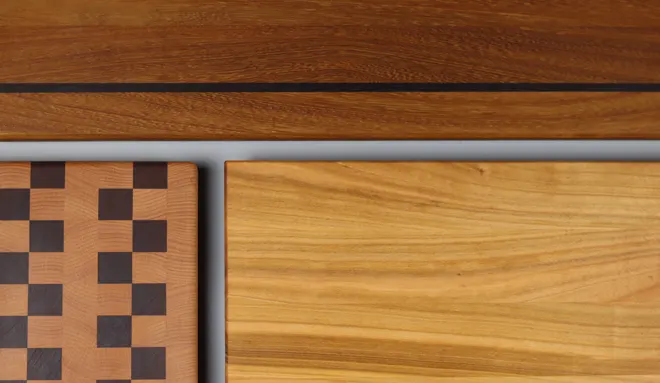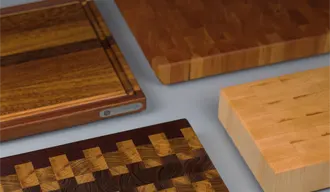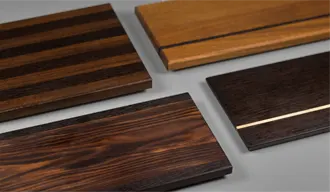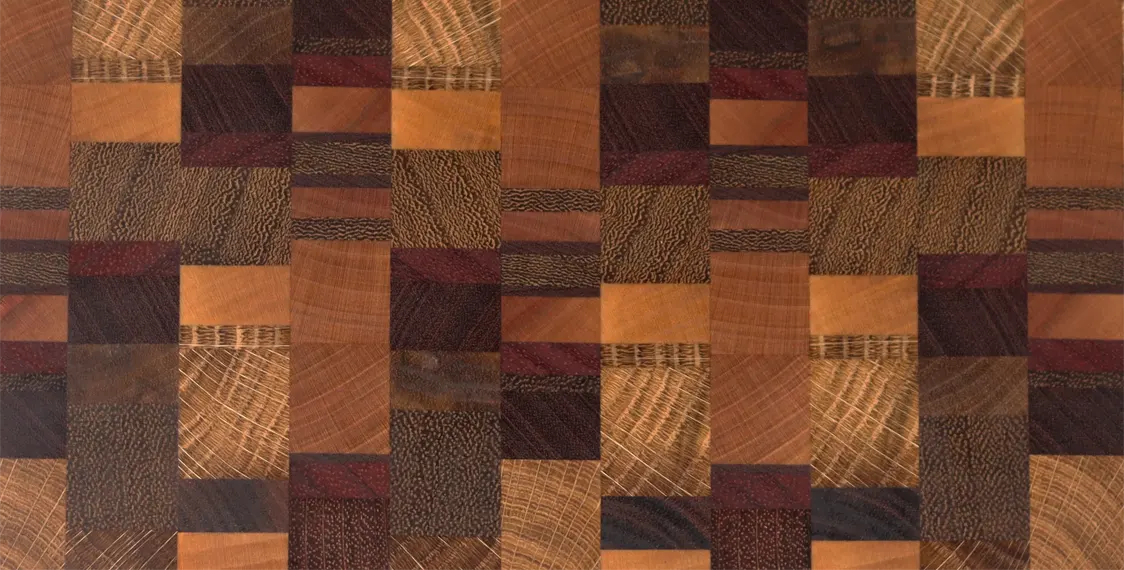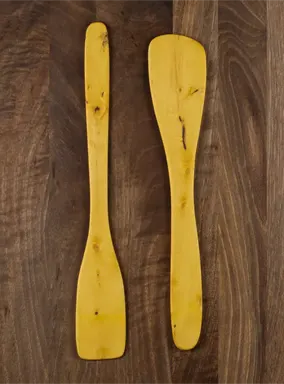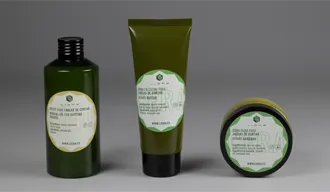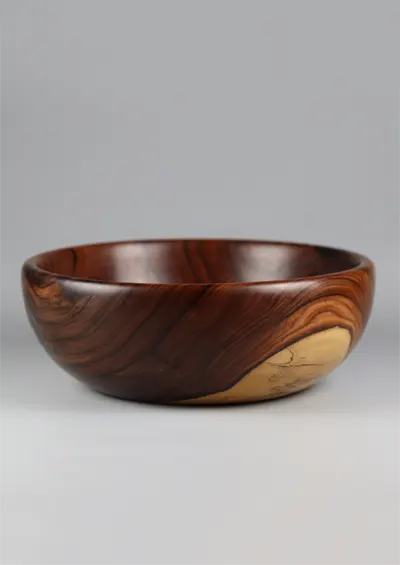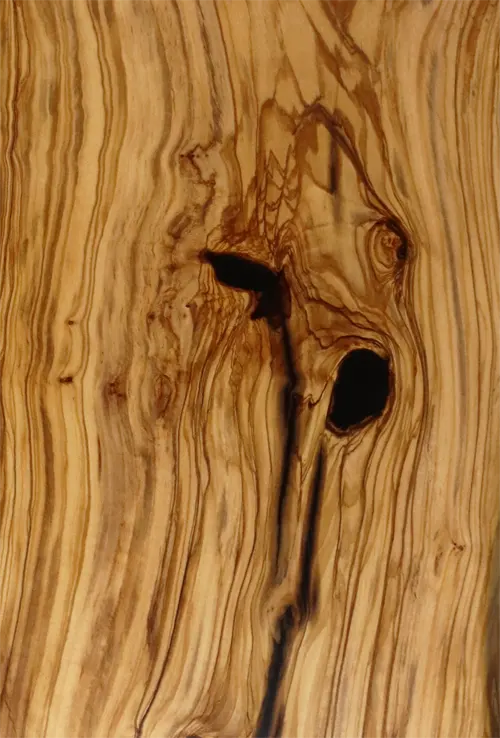Ebony Wood: Complete Guide
Introduction
When we talk about ebony wood we must keep in mind that the term ebony (from the Latin ebenus, from the Greek dýphnos) includes various dark woods belonging to the Diospyros genus and other similar plants.
Its value generally lies in its intense black hue, exceptional density and use in fine cabinetmaking, musical instruments and ornamental pieces.
But not all ebony is created equal. In this guide, we break down the main types:
| Type of ebony | Scientific name | Main origin | Key Notes |
|---|---|---|---|
| Gabon ebony | Diospyros. crassiflora | Western Equatorial Africa | Black ebony |
| Java or Makassar ebony | Diospyros. celebica | Sulawesi (Indonesia) | Brown-black striped |
| Malabar Ebony (black and white) | Diospyros. malabarica | South India and SE Asia | Coromandel or black and white ebony |
Below, we explore each of them.
Gabon ebony (Diospyros crassiflora)
Typically, when we refer to ebony, we’re talking about Gabonese black ebony. In its highest grade, this wood is completely black and, when polished, has a plastic-like appearance.
Currently, its availability is very limited and is mostly reduced to material cut decades ago.
Origin and distribution
Native to the Congo Basin, present in Gabon, Cameroon, Nigeria, Congo, and Equatorial Guinea. They reach 15–18 m in height, with straight trunks ~0.6–1 m in diameter.
Characteristics of Gabon ebony wood
- Colour: Absolute black, with no veins or very few brown/greyish variations.
- Density and hardness: dry weight ≈955kg/m³; specific gravity 0.82–0.96; Janka hardness ≈3080lbf.
- Modulus of rupture/elasticity: MOR 158MPa, MOE 16.9GPa, crushing 76.3MPa.
- Shrinkage: radial 8.3%, tangential 11.2%, volumetric 19.6% (T/R=1.3).
- Very slow drying with a tendency to crack and warp.
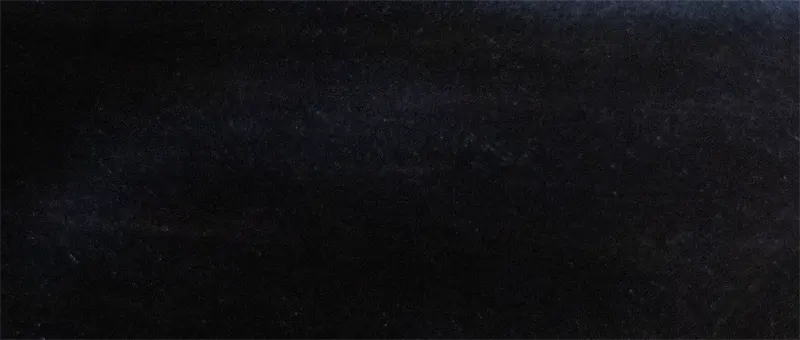
Common uses
Gabon ebony has traditionally been one of the most prized woods in cabinetmaking (hence its name). Its use is not widespread, typically for inlays, string instruments, carving, or piano keys.
Java Ebony / Makassar (Diospyros celebica)
Origin and distribution
Endemic to Sulawesi, Indonesia, especially the Palu and Donggala regions; highly sought after since colonial times for its interesting grain.
Characteristics of Makassar ebony wood
- Color and grain: Broad black and brown or reddish-brown veins, aesthetically appealing.
- Density: between 1000 and 1300 kg/m3, it is one of the densest woods in the world.
- Texture: wavy straight grain, fine texture.
- Difficulty in drying and working: prone to cracking, requires a long drying time.
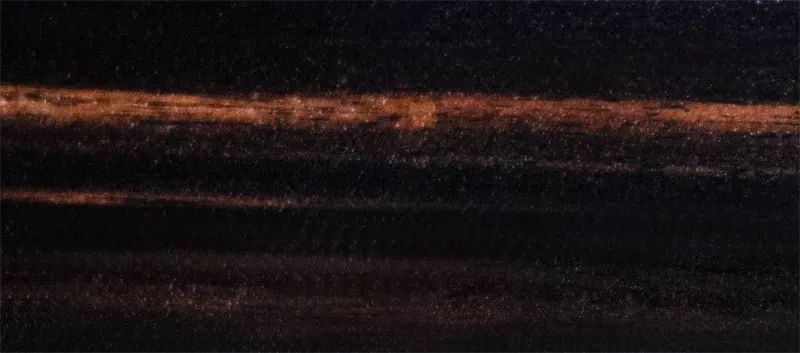
Common uses
Makassar ebony is ideal for fine cabinetmaking, luxury turning, inlays, and interior decoration. It is the most famous ebony wood after pure black ebony.
Malabar Ebony (Black and White) (Diospyros malabarica)
Origin and distribution
It originates from southern India, Sri Lanka, Laos, and Vietnam; it is known as Malabar ebony or pale moon ebony.
Features
- Color: Light background (white or beige) flecked with black veins; some pieces may be completely black.
- Density: ~825kg/m³ (51lb/ft³); basic gravity 0.67–0.82.
- Hardness: Janka ~1780lbf (7920N).
- Texture: fine, straight grain; natural luster.

Common uses
Black and white ebony wood is commonly used in woodturning, cutlery, inlays, instruments, and decorative pieces.
Comparative table of technical characteristics
| Species (Diospyros) | Density (kg/m³) | Janka (lbf) | Color/Pattern |
|---|---|---|---|
| D. crassiflora (Gabón) | 955 | 3 080 | Black aged, no veining |
| D. celebica (Makassar) | 1000-1 300 | ~2 300–3 000 | Black + reddish brown (striped) |
| D. malabarica (Malabar) | 825 | 1 780 | Light background, black veins |
| D. melanoxylon (Coromandel) | ~1 000+ | ~2 500–3 000 | Black or dark green |
| D. mun (Mun Ebony) | 1 065 | ~3 000 | Brown with black veins |
Other woods called ebony
Ebony coromandel (D. melanoxylon)
Extremely dense wood, with a deep black or dark green color. Used in traditional inlays, instruments, and vessels. Formerly used for medicinal purposes and for wrapping tobacco.
Mun ebony (D. mun)
Endemic to Laos and Vietnam. Dense (~1065kg/m³), Janka ~3000lbf. Wood with a rare brown grain. Ideal for turning, inlays, and decorative pieces.
Mauritius ebony (D. tessellaria), Queensland/myrtle ebony (D. pentamera, D. humilis)
Island varieties with a dark brown color and black veins; high density; used locally for artwork and crafts.
Cocus wood (Haematoxylum campechianum)
Not related to Diospyros, but sometimes called green ebony because of its dark color and reddish veining. It has a moderate to high density. There is currently no supply of this wood; only a few logs and small pieces remain.
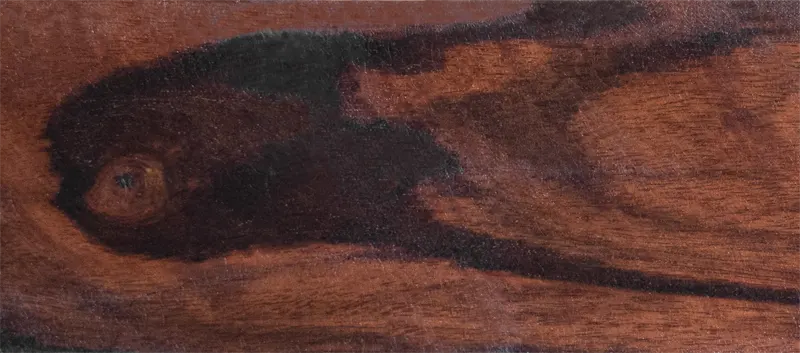
Conclusion
- Gabon Ebony is the common reference for its uniform black, extreme density and hardness.
- Makassar Ebony stands out for its grain and high density.
- Black and white ebony is the most visually interesting due to its color contrasts. However, it is not as dense as the other ebony colors.
- Other varieties (coromandel, mun, mauritius…) provide alternatives with diverse patterns and tones, some with cultural or traditional medicinal value.
Knowing their differences is vital to making appropriate selections based on technical, aesthetic, or historical use.
At Ligna, we stock some of these woods for small, custom-made projects.
FAQ: Frequently Asked Questions About Ebony Wood
What is ebony wood?
Ebony is one of the most prized woods in the world of cabinetmaking and lutherie. It comes primarily from the Diospyros genus, although other unrelated species also exist that are called ebony due to their color and density.
How many species of ebony exist?
There are several species of ebony, but the best known and most used are:
- Diospyros crassiflora (Gabon ebony)
- Diospyros celebica (Java or Makassar ebony)
- Diospyros malabarica (Malabar ebony or black and white)
What differentiates Gabon ebony from other species?
Gabon ebony (Diospyros crassiflora) is known for its absolute black color and exceptional density. It is native to western equatorial Africa and is primarily used in fine cabinetmaking and musical instrument making.
What characterizes Javanese or Makassar ebony?
Java ebony (Diospyros celebica) is native to the island of Sulawesi, Indonesia. It is distinguished by its striped brown and black grain, which gives it a unique and decorative appearance.
What is Malabar ebony?
Malabar ebony (Diospyros malabarica) originates from southern India and Southeast Asia. It’s known for its combination of black and white hues, giving it a distinctive appearance.
Some woods from other species are called ebony because of their dark color and high density, although they do not belong to the Diospyros genus.
What is the difference between ebony and lignum vitae?
Lignum vitae (Guaiacum officinale) is an extremely dense and hard wood native to the Caribbean and Central America. Although its color is dark, it does not belong to the Diospyros genus and is primarily used in industrial and nautical applications.
What is green ebony?
Green ebony (Guaiacum sanctum) is a species of lignum vitae with greenish hues. It is used in carpentry and crafts, but is not a true ebony of the Diospyros genus.
Why are ebony and guaiacwood confused?
The confusion between ebony and guaiac wood arises because both woods are dense, dark, and used in similar applications. However, ebony comes from the genus Diospyros, while guaiac wood belongs to the genus Guaiacum.
Is ebony a sustainable wood?
The sustainability of ebony depends on its origin. It is essential that the wood comes from legal and certified sources, such as those certified by the FSC or CITES system, to ensure responsible management and prevent illegal exploitation.
Why is ebony so expensive?
Ebony’s high cost is due to its slow growth, limited availability, and high demand for luxury applications. Furthermore, its extraction and processing require specialized techniques due to its hardness.
How is ebony worked?
Ebony is a very hard and dense wood, which can make it difficult to work with. It’s recommended to use sharp tools, slow cutting techniques, and a good cooling system to prevent overheating.
What are the applications of ebony?
Ebony is used in the manufacture of musical instruments (such as piano keys and guitar tuners), high-quality furniture, sculpture, turning and carving, as well as in the manufacture of tool handles and luxury goods.
How do you distinguish ebony from other dark woods?
Ebony is characterized by its deep black color, fine grain, and smooth texture. Its density is so high that it can sink in water, which distinguishes it from other dark woods.
What precautions should I take when working with ebony?
When working with ebony, it’s important to wear personal protective equipment, such as masks and goggles, as the dust can be irritating. Additionally, ensure good ventilation and use appropriate tools to avoid accidents.
Otras entradas del blog
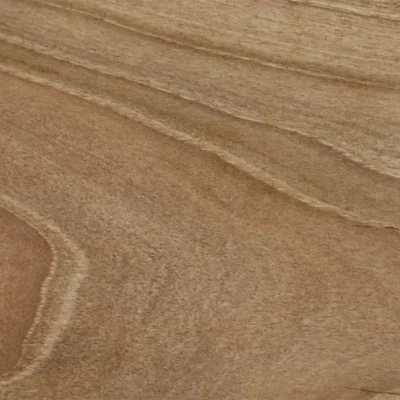
Walnut Wood: Uses and Characteristics
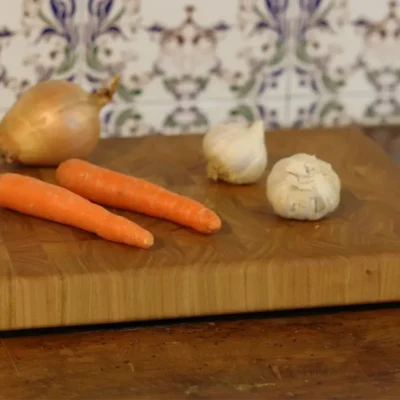
What is the best cutting board?

How many species of wood are there in the world?

How to Care for Wood Cutting Boards like a Pro
Nuestras tablas de cortar:
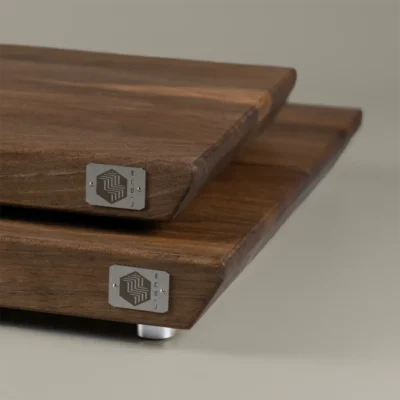
Linea
Walnut Walnut cutting board
Linea
WalnutWalnut cutting board
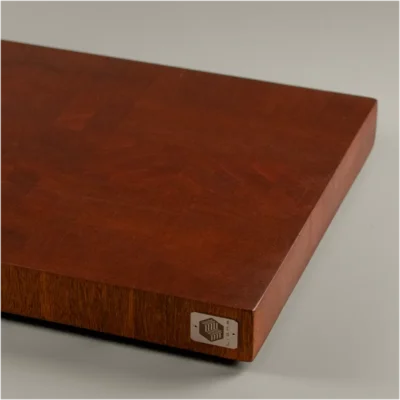
sapele end grain
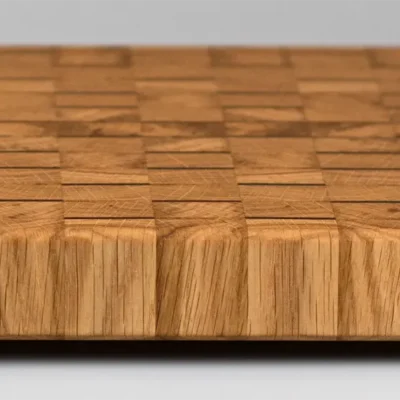
Summer endgrain Cutting Board
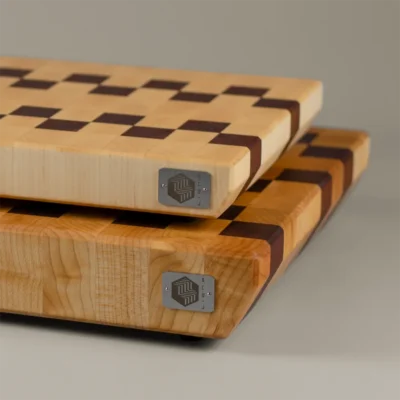
Rubra
butcher block
